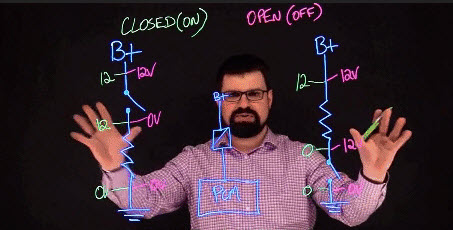The lightboard can be a great tool for creating videos that engage your students and make it easier to understand complex topics. However, it can take some practice to learn what to do and what not to do when using this tech tool to get the best quality results. That’s why we recommend that anyone planning to shoot a video using the lightboard review these best practices and tips for success prior to coming into the studio.
Before You Shoot
Making a lightboard video will take some advance preparation on your part. Here are some things that you can do in the days leading up to your lightboard session to make the process more successful.
- Keep it short. Lightboard videos should be a single topic that can fit easily on a single board. If your video requires erasing or a second board, it is likely too long.
- Organize your content. Develop an outline or full script and rehearse it ahead of time. The more prepared you are to shoot the video, the easier the process will be.
- Practice on a whiteboard. Spacing can be an issue on the Lightboard, so it’s a good idea to practice laying out any drawings or text that you want to use in your video ahead of time.
What to Wear
We don’t want to cramp your style, but certain colors and types of clothing don’t work well when using the lightboard. Here’s what to wear the day of shooting.
- Go dark. Dark colors, like gray, navy, deep red, etc, are best for blending into the background but not disappearing. Lighter shades make the neon markers the lightboard uses hard to read.
- Avoid black. While dark is good, don’t go too dark, as black will make you blend in with the black background the lightboard requires.
- Say no to text or logos. Your lightboard video will be flipped horizontally in post-production (this is to allow the text and drawings on the lightboard to appear correctly) so any text on clothing will show up backwards.
Shooting the Video
It’s time to shoot! Before you begin, however, make sure you keep these things in mind.
- Stay close to the board. Stepping away from the board will cause you to appear in shadow and may also affect the camera focus, making you appear blurry.
- Be conscious of the lightboard space. There’s only so much lightboard real estate to work with, so think about how much room you’ll need to write and draw your content.
- Keep your face unobstructed. Move to the side as you write and lecture so that your face isn’t covered by text. This makes it easier to see you as well as to read the board.
- Point at content. When you are speaking about something you have put on the board, point to it to draw attention to that specific item. A couple of tips for successful pointing–make sure to point from the side and not from the back and avoid pointing or gesturing with the markers–this will make it much easier to see what you’re pointing to.
- Look at the camera. When you are not drawing or writing, you will want to address the camera–it represents your audience.
- Don’t cap markers. The markers will survive being upcapped for the duration of your video. Putting on and removing caps is loud and distracts from your video.
- Aim to reduce squeak. The markers used for the lightboard can sometimes squeak. To reduce this, use a light touch when writing and drawing.
Other Tips
- Have fun with it! The more fun you’re having, the more enjoyable your videos will be for your students.
- Remember, we can edit in post-production. We can add text, take out your worst fumbles, combine clips, and much more.
- Aim for good, not perfect. Your goal is to get students to understand a topic, so as long as your video does that, it doesn’t need to be flawless. Keep that in mind and don’t get stressed.
- Check out existing videos. It can be really helpful to see what others have done in lightboard videos both to prepare you and to provide inspiration with regard to what can be done with the technology.
Read More
There are lots of great guides for using the lightboard out there, as many other colleges and universities utilize them. While we’ve covered the most important topics here, you can continue learning on these sites.
You can find this guide to the lightboard on our Knowledge Base as well. Looking to use the lightboard? Give us a call or an email and we’ll set up a session. We can help you plan, shoot and share a lightboard video!



Your point of view caught my eye and was very interesting. Thanks. I have a question for you. https://www.binance.com/register?ref=P9L9FQKY